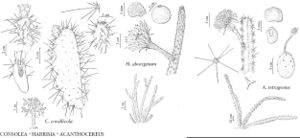Difference between revisions of "Consolea corallicola"
Addisonia 15: 25, plate 493. 1930.
imported>Volume Importer |
imported>Volume Importer |
||
| Line 64: | Line 64: | ||
|publication year=1930 | |publication year=1930 | ||
|special status=Illustrated;Endemic;Conservation concern | |special status=Illustrated;Endemic;Conservation concern | ||
| − | |source xml=https:// | + | |source xml=https://bitbucket.org/aafc-mbb/fna-data-curation/src/2e0870ddd59836b60bcf96646a41e87ea5a5943a/coarse_grained_fna_xml/V4/V4_292.xml |
|subfamily=Cactaceae subfam. Opuntioideae | |subfamily=Cactaceae subfam. Opuntioideae | ||
|genus=Consolea | |genus=Consolea | ||
Latest revision as of 21:57, 5 November 2020
Trees to 2 m; trunk ± elliptic in cross section, heavily armed. Stem segments from top of trunk, tending to grow in 1 plane, not equilateral, falcate, 12–30 cm, not reticulate, copiously armed; areoles 1–3+ cm apart, obdeltate, 3 × 1.5 mm; wool tan, encircled by gray. Spines 5–9 per areole, salmon colored, aging light gray, needle-shaped, to 12+ cm; spines of branches smaller and more flexible than those on trunk, mostly in marginal and submarginal areoles. Glochids usually not visible or, sometimes, small short yellowish tuft, particularly on areoles of fruits. Flowers appearing bisexual, emitting faint rotting-meat odor; outer tepals conic, fleshy; inner tepals bright red, obovate-apiculate, to 25 mm; stigma lobes light red, turning dark red upon pollination. Fruits sometimes proliferating when seedless, yellow, obovoid to clavate, usually slightly curving upward, 25–60 mm, fleshy; areoles prominent; spines spreading. Seeds irregular in outline, 7–9 mm diam.; girdle cristate. 2n = 66.
Phenology: Flowering year-round (peak Dec–Apr).
Habitat: Hammocks
Elevation: 0 m
Discussion
Of conservation concern.
The name Opuntia spinosissima of authors, not (Martyn) Miller, has been applied to Consolea corallicola.
Consolea corallicola is endemic to the Florida Keys and near extinction. It is already extirpated from several keys and is known from fewer than twenty plants in the wild. Hurricanes, deer, and cactoblastis moths impact the health of the population.
Consolea corallicola is in the Center for Plant Conservation’s National Collection of Endangered Plants.
Selected References
None.

